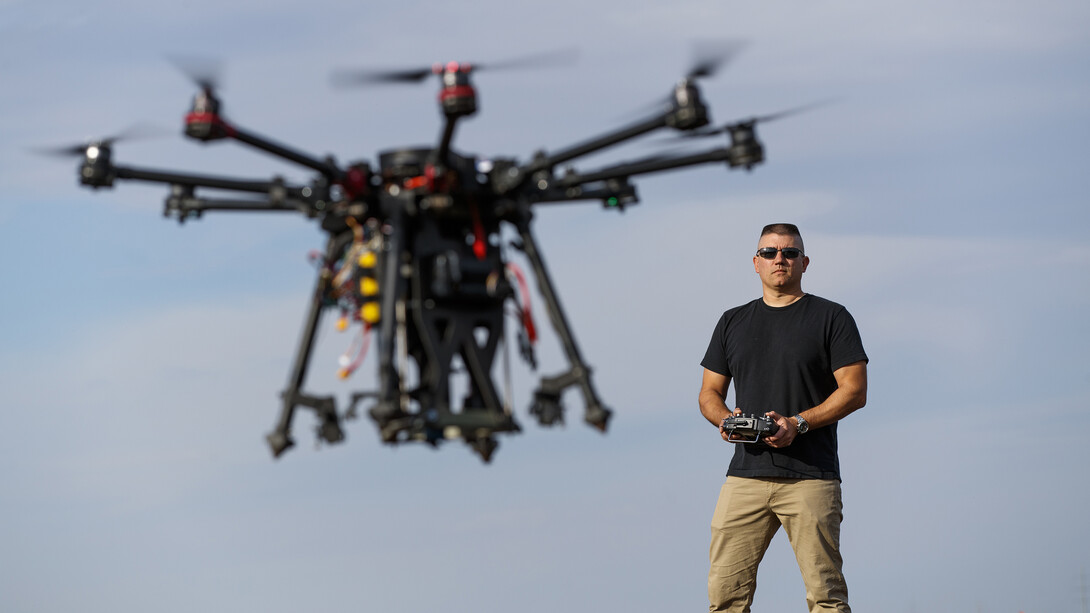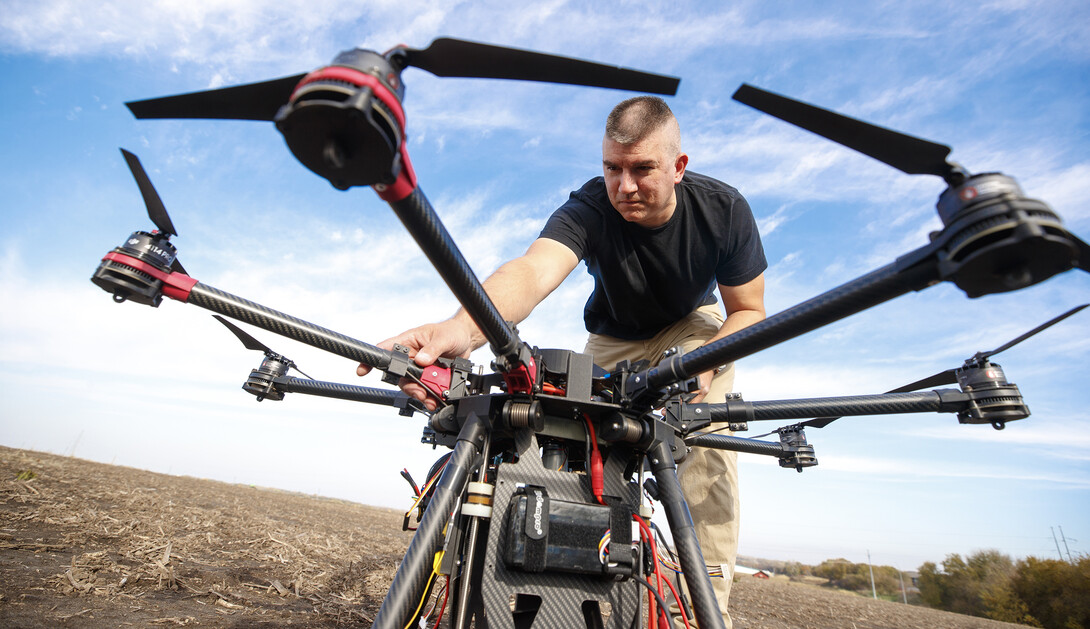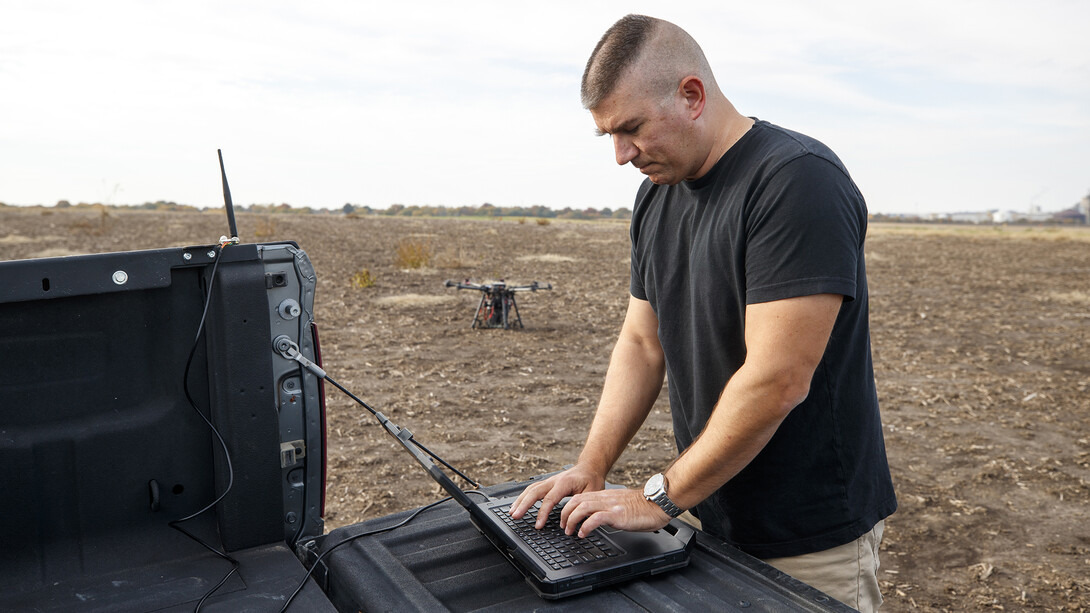
In a transition from military career to college life, Nebraska’s Adam Plowcha traded 10 tons of screaming steel for 25 pounds of thrumming carbon fiber.

A retired U.S. Navy pilot who flew the Sikorsky SH-60 Bravo Seahawk for 20 years, Plowcha is now a third-year University of Nebraska–Lincoln graduate research assistant and part of the NIMBUS Lab team. His research through the lab focuses on building, programming and flying new drone technologies — including those with possible national defense uses.
“Part of the thrill in what I did as a military pilot was having definitive and varied missions,” Plowcha said. “It’s not quite at the same adrenaline level as flying 20,000 pounds of screaming steel off the back of a ship, but I’ve been able to rekindle that thrill through my research here at Nebraska.”
“It’s not quite at the same adrenaline level as flying 20,000 pounds of screaming steel off the back of a ship, but I’ve been able to rekindle that thrill through my research here at Nebraska.”
— Adam Plowcha, retired Navy pilot and NIMBUS Lab researcher

Taking flight
Inspired by his dad’s Vietnam-era military service stories, Plowcha decided to join the U.S. Navy during his senior year at Millersville University. Two years after earning a bachelor’s degree in computer science, he was named a Navy pilot.
“My dad was excited when I told him I was joining the Navy, but Mom was not so happy about it,” Plowcha said. “Her tune changed when I got a pilot slot. Then it became cool.”
Most of his military experience was spent flying the Seahawk off cruisers, destroyers and frigates at night, assisting the U.S. Coast Guard with counter-narcotics missions. The work involved chasing down speedboats used to transport drugs into the United States, as well as providing cover and support as the Coast Guard conducted boarding operations.
He was selected to train at the U.S. Navy Strike and Air Warfare Center’s tactics instructors program — colloquially known as Top Gun — where he learned how to fly a helicopter in a variety of scenarios, including against fighter jets such as the F/A-18 Hornet. He also helped train other pilots, served in a variety of leadership roles — including a year as the aviation safety officer at Camp Lemonnier in Djibouti, Africa — and earned a master’s degree, also in computer science, from Nova Southeastern University.
His final assignment was at the rank of lieutenant commander as an information operations planner with U.S. Strategic Command.
As he approached retirement, Plowcha opted for a second career in teaching.
“When I was a flight instructor, I realized an ability and interest in teaching and classroom stuff,” Plowcha said. “That made sense because I was surrounded by it growing up, as my mom was a college professor and Dad taught high school history.”

Landing in academia
A search for a doctoral program near Omaha, allowing him to keep his family in one location, led Plowcha to Nebraska and the NIMBUS Lab.
NIMBUS — Nebraska Intelligent MoBile Unmanned Systems — is a center focused on research and technology to develop more capable and dependable unmanned aerial vehicles. Recent lab projects include a drone that can collect water samples from lakes, streams and ponds, and a fire-starting model that may aid conservation efforts.
“The first time I walked into the NIMBUS Lab, there were drones hanging on the wall, a 3-D printer grinding away in the corner, guys flying stuff and computers everywhere,” Plowcha said. “My first thought was that I could really enjoy working here.
“I never expected it, but at Nebraska I found the perfect place where I could combine my two fields: flying and computer science.”
After navigating the transition from military to college life, Plowcha is now hitting his academic stride. He is the lead doctoral student on a project funded through Nebraska’s National Strategic Research Institute, a collaboration between the university and U.S. Strategic Command with a focus on becoming a global leader in research on combating weapons of mass destruction.
The project involves the development of a drone that can deploy sensors into holes it drills into soil.
“While it is an NSRI project, it also involves funding from the (National Science Foundation) and (U.S. Department of Agriculture),” Plowcha said. “Basically, it’s technology that has multiple applications — from farmers who need to track moisture content 6 inches down to using seismic sensors to gauge game and other movements through a particular area.”
He is also working on the development of a technique where a drone controls a parachute during descent, allowing it to save battery power for extended high-altitude missions.

The lab experience now has Plowcha considering future career paths in both academia and industry.
“I still hedge toward academia, but working in the NIMBUS Lab has opened my eyes to many other opportunities,” Plowcha said. “My career as a Navy pilot was an amazing experience, but this drone work is very satisfying. It’s offering new challenges and the opportunity to play with some very cool toys every day.
“I think I may have found what I want to do when I grow up.”







